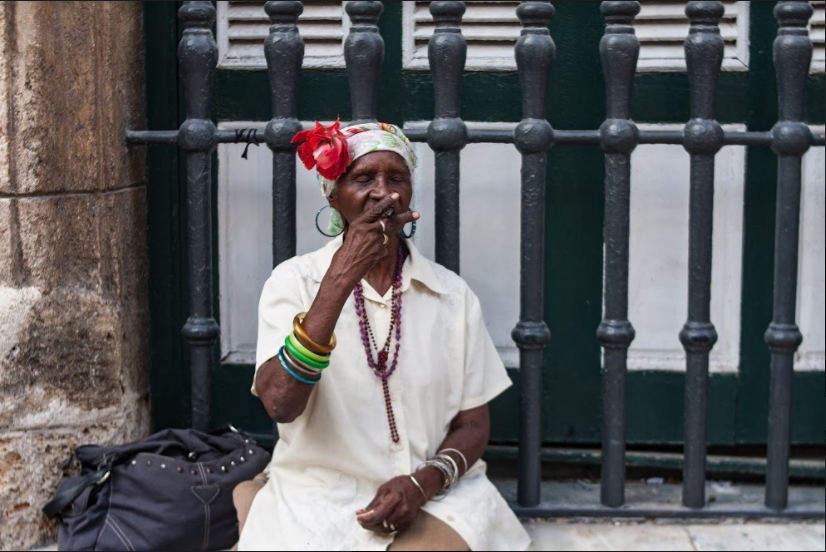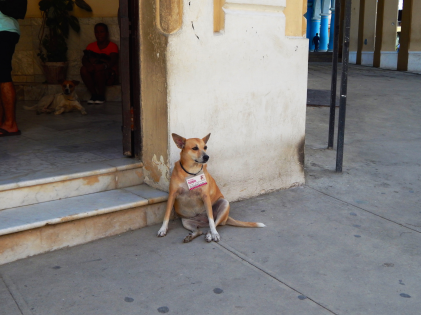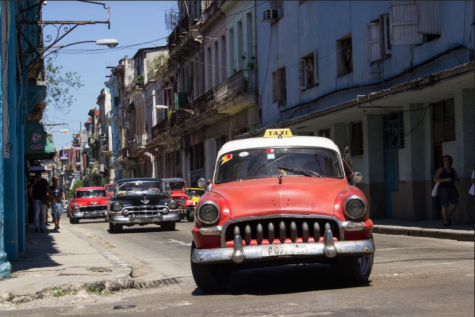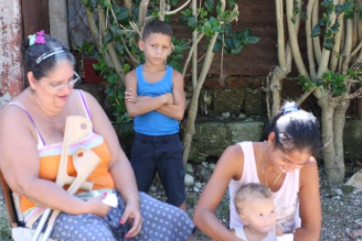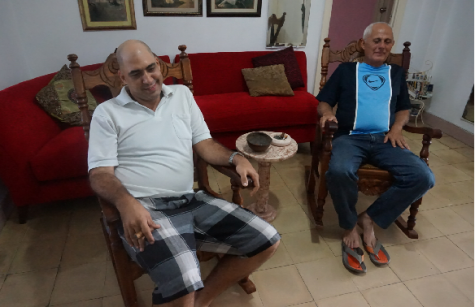Portraits of working women: Overcoming ‘machismo’ in Cuba
Inside the dim doorway of a crumbling, unmarked building in Old Havana, 33-year-old Lily Castro Sevilla prepares her makeshift wooden nail station for the next customer. Half-empty nail polish reminiscent of the 1980s teeters in racks on the modest table.
While customers sit on metal chairs and blow on their wet nails, a young girl emerges from a back room and opens the refrigerator behind her mother’s workstation. A photo of a young boy hangs crooked behind the door, cluing customers in on the fact that this particular nail salon is situated in the five-bedroom home of Sevilla.
Like many women in Cuba, Sevilla has a degree from the University of Havana in a different field—social psychology—but after graduating, she was unable to find a well-paying job. Five years ago, she became licensed to paint nails and opened her own business in the front room of her home.
In Cuba, this is a common occurrence, as women dominate much of the workforce. They work as museum curators, doctors, professors and teachers; they own businesses and hold public office. They make up 66 percent of the labor force and more than 70 percent of professionals are women, according to a study published in 2011 by the American Association of University Women or AAUW.
Today, women also hold 80 percent of education jobs, 69 percent in health care and 66 percent in the legal field, according to the AAUW. But before the revolution, in the 1950s, only five percent of university graduates were women and women only made up 12 percent of the workforce, according to a 2015 article in the New York Times.
The surge of women in the workforce over the past 50 years can be attributed to the women’s movement, which began during the revolution under the rule of Fidel Castro. The movement dates back to 1960 when Castro formed the Federacion de Mujeres Cubanas (FMC), the official, non-governmental organization (NGO) that advocates for women’s rights.
The FMC was headed by Vilma Espin, wife of current Cuban President Raul Castro, until her death in 2007, according to the FMC.The organization is famously characterized by the image of Espin in a combat uniform, shouldering a military rifle, and is the epitome of feminism in Cuban culture.
The FMC was formed to incorporate and elevate women in economic, political, social and cultural positions within Cuban society and empower them with equal rights and opportunities, according to a 2003 FMC statement. Today, there are around 4 million members.
“Socialism for Cuban women means freedom, independence, sovereignty, dignity, social justice, security for the education and development of their children, the right to equality, to life, to decide their own destiny, to work for the future dreamed of and defended with all forces,” Espin famously stated.
To this day, her words motivate and empower the organization to continue her efforts, evidenced by the use of her quote in a 2016 article by the FMC in Granma, the country’s official newspaper of the Communist Party.
In many ways, women have achieved some semblance of gender parity in Cuba; however, a paradox exists. According to Teresa Diaz Canals, a doctor of philosophical sciences of 35 years at the University of Havana, many believed that women’s inequality issues were resolved after the revolution due to the creation of new jobs, placement of women in politics and general changes to society, but this is not the whole truth.
Even within the FMC, the official advocate for Cuban women, it is understood that the interests of the revolution come first and women second, according to Canals.
While women in Cuba have more equal rights than they did 50 years ago, they often express frustration at the “machismo,” a strong sense of masculine pride or power, that pervades Cuban culture.
High rates of domestic violence persist beyond the picturesque façade of 1950s cars, rum and cigars that come to mind when much of the world envisions Cuba. There is no law against domestic violence in the Cuban constitution and women are virtually unprotected, explained Canals.
“These women, they can go to the police station and sometimes they receive help, but it depends on the policeman,” said Canals. Women can go to the FMC, which has the tools and knowledge to deal with these kinds of problems, but “when you’ve got one organization and the projection of that organization is revolution first and women after this, you don’t believe in that,” she said. “Usually when women receive this kind of violence they don’t go anywhere and they take it all into their own hands.”
While the government campaigns against domestic violence and casts an “official projection” of the revolutionary feminist movement, it isn’t always enough, according to Canals.
This projection applies to other aspects of women in society. Many women are put in positions within the government regime to make it look like equal representation; however, the amount of influence they actually have is questionable. Canals said she doesn’t expect to see any real change until all of the current regime dies out completely.
In terms of overt political activism, the FMC seems to be quieter at present than in past decades; however, working women in Cuba, like Sevilla, embody the positive face of this movement.
While Sevilla pays a monthly tax to the government to own her own business, she also makes a profit, which she says is enough to live on. According to Canals, 75 percent of the population receives between 16 and 20 CUC a month, 30 CUC for top-paying jobs. CUC is one of two forms of currency in Cuba and is paired to the USD, mainly used by tourists.
Sevilla employs one other woman, whom she pays 2 CUC a day, but charges 5.50 CUC to tourists and 3 CUC to locals, in order to make a profit. The majority of her clients are locals but her most popular tourist clients are American first and Spanish second.
Customers may pay anywhere from 7 to 10 CUC for acrylic nails, depending on which materials are available. The nail polish itself costs Sevilla between 2 and 3 CUC, but it’s an investment and sometimes women bring in their own polish.
It is more expensive to maintain a small business than work in a larger state-run nail salon, due to the cost of the license, according to Sevilla. But at the end of the day, business owners have more freedom and she feels it is worthwhile.
Other professions pose their own set of challenges for women who are trying to make ends meet. Some women work in sweatshop-style sewing factories and others peddle bright balloons and souvenirs on the streets.
Women clad in bright traditional costumes will pose with cigars for tourists in the hopes of making a CUC or two, others paint tiny metal revolutionary figurines to sell in their shop or hand-roll cigars in the back of a cigar and rum market. Regardless of their craft, there seems to be no end to women’s resourcefulness or ingenuity in Cuba.
For women trying to carve a niche in the music industry, a male-dominated field, the pressure to be unique and talented is strong. It’s 10 p.m. on a Friday night in Old Havana and eight Cuban women, color-coordinated in white, make their way to the front of the Azucar Lounge, located in Plaza Vieja. They join their instruments on the stage—bass, drums, trumpet, classic guitars—with confidence and expertise.
A few of the women speak broken English, but that doesn’t matter when it comes to the music; their repertoire is made up of 35 songs, which include some English classics like “No Woman, No Cry” by Bob Marley. All of the English renditions are infused with a Cuban flair through the use of percussion instruments.
The name of the band is 8va Nota, pronounced “eighth note,” and they are defending their genre, according to band founder Yohana Nuñez Gallardo, 29.
Gallardo, who heads another band called Mystica, said one of the requirements to join 8va Nota is to be versatile. She alone plays the bass, classical guitar and is a lead singer; most of the eight girls in the group are also multi-talented.
The group, which was formed three years ago, practices once a week for two hours a day and performs the other six days. On Tuesdays, they perform twice; first at Azucar and then at another restaurant on the other side of town. They are in the process of recording their first CD and the music pays well enough to support themselves without a second job. However, the real goal is to be known internationally as a band of girls who perform a large variety of rhythms, according to Gallardo.
Several members of the group, including herself, have traveled and performed larger concerts; however, the ultimate dream is to perform in large venues as a complete unit. In order for this to be possible, the group must establish themselves in Cuba first.
“We want to be different,” said Gallardo. “We have the quality of music to make it far in the world. The girls from 8va Nota are fighting and defending the genre.”
Amalia Salas Fernandez, a 20-year-old percussionist for 8va Nota and a student at the Instituto Superior de Arte or ISA in Havana, said being a part of the group is challenging, but there’s no competition amongst the women in the group; they understand that they’ll be more successful if they remain unified as a band.
Instead, their main obstacle is proving themselves in a male-dominated industry. “In order for women to succeed, we have to be better than the men and better than the best,” said Fernandez.
Her words echo the sentiments of many Cuban women throughout different capacities and fields. In a “machismo” society, gaining true equality seems to be an ongoing, conscious effort. “Men underestimate women, but we [women] also underestimate ourselves,” said Gallardo. “We don’t put our feet forward because women put up a barrier. We have to overcome this wall to achieve things.”


